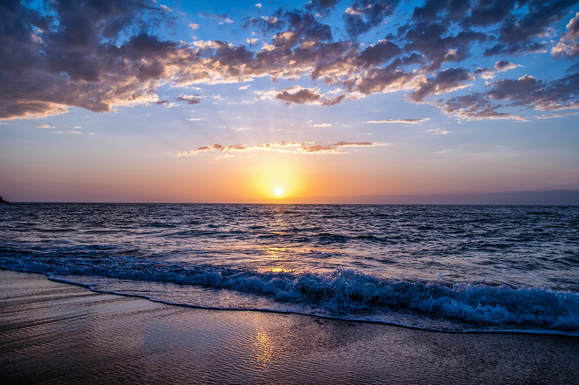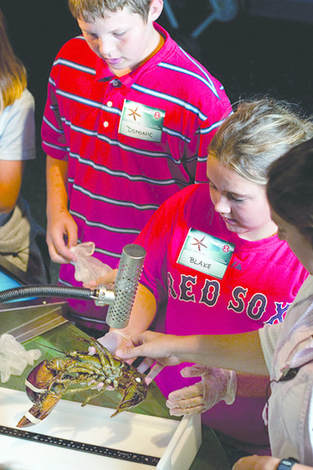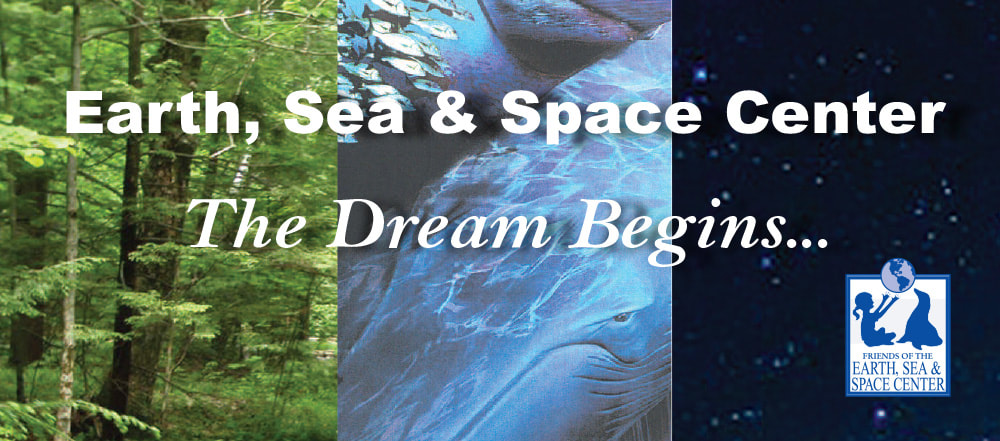The Vision
|
Imagine a place where you journey through time and see natural history unfold.
Imagine being immersed in undersea worlds, where you are close to the varied creatures of the deep. Imagine learning in a dynamic, hands-on way about the wonders of our waterways, weather and ecosystems. One day, you can...at the Earth, Sea & Space Center in Dover, New Hampshire. |
"Do good by drinking well!" |

Here, visitors will learn how the waters of our world shape our earth, and our lives.
From a placid lake to a tumbling river, to the vast ocean stretching to the horizon, each affects the other, and in turn, the environments around them.
And the connection doesn’t end there. Earth, oceans and weather are constantly influencing each other, from the slide of a rock plate to the pull of the moon and the crash of a wave. Understanding how these forces relate is key to the health of our planet. At the museum, visitors will see how weather and climate affect our past, present and future. They will hunt for geological clues to our history, and examine our changing landscape. They will also learn the critical role that space technology plays in the health of our world. From satellites used to track the health of coral reefs to lessons learned on Mars, our forays into the heavens aid our research here on earth.
At the Earth, Sea & Space Center, we focus on diversity and connections: The diversity of our planet’s environments and its ever-changing forces, and the connections between these ecosystems and our planet’s future. Land and sea, climate and weather, people and planet--we are all connected, and voyagers on the same journey of discovery.
From a placid lake to a tumbling river, to the vast ocean stretching to the horizon, each affects the other, and in turn, the environments around them.
And the connection doesn’t end there. Earth, oceans and weather are constantly influencing each other, from the slide of a rock plate to the pull of the moon and the crash of a wave. Understanding how these forces relate is key to the health of our planet. At the museum, visitors will see how weather and climate affect our past, present and future. They will hunt for geological clues to our history, and examine our changing landscape. They will also learn the critical role that space technology plays in the health of our world. From satellites used to track the health of coral reefs to lessons learned on Mars, our forays into the heavens aid our research here on earth.
At the Earth, Sea & Space Center, we focus on diversity and connections: The diversity of our planet’s environments and its ever-changing forces, and the connections between these ecosystems and our planet’s future. Land and sea, climate and weather, people and planet--we are all connected, and voyagers on the same journey of discovery.

What is the Earth, Sea & Space Center?
The Earth, Sea & Space Center is a project in development in Dover, New Hampshire. The organization behind the project is the Friends of the Earth, Sea & Space Center, a 501(c)3 nonprofit. The goal is to create a facility that is outstanding in its educational, environmental and economic benefits.
We envision a facility which combines large-scale aquarium and science museum exhibits, and highlights the complex relationship between earth, sea, and space. Our aim is to provide educational opportunities for every age and interest level. We are committed to exhibits and programs that are dynamic, interactive, fresh, and scientifically current.
Our project was initially conceived as a large-scale aquarium, but as we met with scientists, educators and exhibit developers, we realized that a more important and comprehensive story needed to be told. Science today is being taught differently and research is following new paths. There is a more holistic theme throughout. The best science classes do not just look at plants or trees or animals individually, but rather at how they relate to each other and their overall environment. The world does not exist in a vacuum and neither does science education.
As a result of these findings, several years ago we changed our mission from that of building a large-scale aquarium to building an earth, sea and space center.
If you have ever been to a world-class aquarium, such as those in Baltimore, Maryland, and Monterey, California, or a museum with incredible exhibits, such as those found at the Smithsonian's National Museum of Natural History, then you know the power of a first-rate museum. You feel immersed in the experience; the educational process is fun, exciting and real.
Picture these places. Remember the enjoyment you felt. Picture a facility of that quality on the New Hampshire Seacoast. We are proposing a top quality science museum of suitable size to draw a significant audience, but small enough to fit with the region.
The Earth, Sea & Space Center is a project in development in Dover, New Hampshire. The organization behind the project is the Friends of the Earth, Sea & Space Center, a 501(c)3 nonprofit. The goal is to create a facility that is outstanding in its educational, environmental and economic benefits.
We envision a facility which combines large-scale aquarium and science museum exhibits, and highlights the complex relationship between earth, sea, and space. Our aim is to provide educational opportunities for every age and interest level. We are committed to exhibits and programs that are dynamic, interactive, fresh, and scientifically current.
Our project was initially conceived as a large-scale aquarium, but as we met with scientists, educators and exhibit developers, we realized that a more important and comprehensive story needed to be told. Science today is being taught differently and research is following new paths. There is a more holistic theme throughout. The best science classes do not just look at plants or trees or animals individually, but rather at how they relate to each other and their overall environment. The world does not exist in a vacuum and neither does science education.
As a result of these findings, several years ago we changed our mission from that of building a large-scale aquarium to building an earth, sea and space center.
If you have ever been to a world-class aquarium, such as those in Baltimore, Maryland, and Monterey, California, or a museum with incredible exhibits, such as those found at the Smithsonian's National Museum of Natural History, then you know the power of a first-rate museum. You feel immersed in the experience; the educational process is fun, exciting and real.
Picture these places. Remember the enjoyment you felt. Picture a facility of that quality on the New Hampshire Seacoast. We are proposing a top quality science museum of suitable size to draw a significant audience, but small enough to fit with the region.

Where We Are Now & Next Steps
Phase One includes hiring of contractors, permitting, and conducting the Master Plan. While preliminary studies have been done, based on the facility locating somewhere on the New Hampshire Seacoast, the Master Plan is site specific and provides an up to the minute assessment of the site and its concepts and needs.
What does the Master Plan include?
Nothing proceeds without the master plan. The information from the master plan is critical to determining whether the project goes forward or not. We do not want to proceed with a project that is not fully researched.
If the information provided by the plan shows the project is viable in this location, then we will finalize our agreement with the City and proceed. The master plan data is also critical to our capital campaign.
The capital campaign is estimated to take about three years. Construction will take about two years. Go to our About section to learn more.
- We have a Letter of Understanding with the City of Dover for the site.
- We have completed our geotechnical work and buildabilty study and the site is viable.
- We have hired our exhibit designers. (See The Development Team)
- We have hired our project manager.
- We have hired our architect.
- We are now raising funds for Phase One. This is $400,000, including a contingency factor.
Phase One includes hiring of contractors, permitting, and conducting the Master Plan. While preliminary studies have been done, based on the facility locating somewhere on the New Hampshire Seacoast, the Master Plan is site specific and provides an up to the minute assessment of the site and its concepts and needs.
What does the Master Plan include?
- The master plan determines the final size, look, and cost of the facility.
- It determines the storyline, program and exhibit concepts, and tests their marketability.
- It determines where visitors will come from, seasonal highs and lows, and firms up projected numbers.
- It troubleshoots any potential problems.
- It looks at parking and traffic, impact on services, and on other attractions.
- It estimates average year-round operating costs.
- It provides plans for future marketing.
- It includes a three-day citizens’ workshop so we have public input.
Nothing proceeds without the master plan. The information from the master plan is critical to determining whether the project goes forward or not. We do not want to proceed with a project that is not fully researched.
If the information provided by the plan shows the project is viable in this location, then we will finalize our agreement with the City and proceed. The master plan data is also critical to our capital campaign.
The capital campaign is estimated to take about three years. Construction will take about two years. Go to our About section to learn more.
|
|
Stay informed — click here to sign up for updates through our Contact Page |

